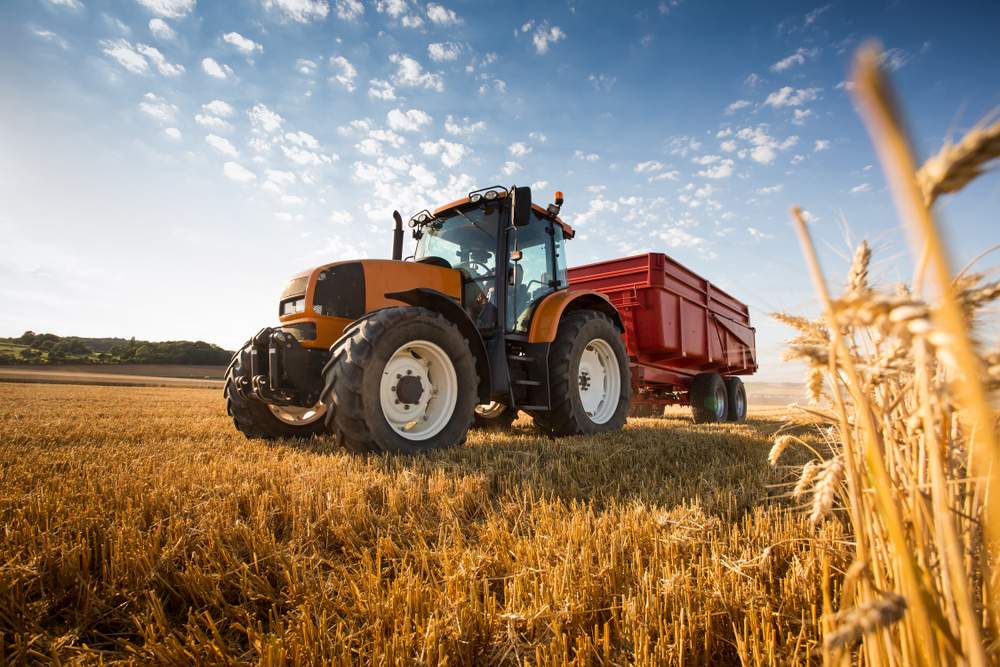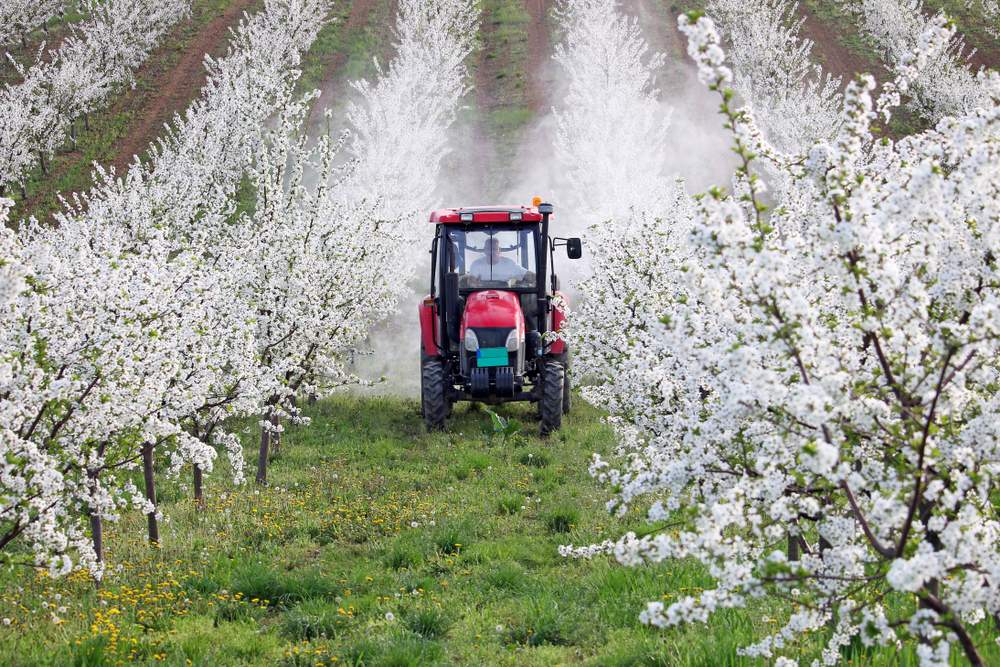What are the different types of tractor used in agriculture?

For those who work in the farming industry, tractors are a part of everyday life. Whether they are used for cultivating soil, managing livestock, or hauling other heavy machinery like harvesters, tractors can be used to execute any of these tasks with ease.
But not all tractors are built equal; there are different types of tractors for different uses. For instance, industrial tractors such as earth-moving tractors are mainly used in landscaping and aren’t designed to be used for agriculture.
It can be a little tricky to differentiate between agricultural and industrial tractors, which is why it’s essential to understand the distinction before making a purchase.
To clarify some of the confusion, this article will explore the 10 most common tractor types in agriculture, what tasks they are best suited for, and what to consider when choosing one.
What are the different types of tractor used in agriculture?
From garden tractors that can cut grass and complete simple tasks around a garden or small field, to row crop tractors that are used in ploughing and harrowing on large farms, there are a plethora of tractors to choose from.
There are even specialised tractors that are suited for a particular job, such as an orchard tractor for use in orchards and vineyards. Let’s take a look at all 10 tractor types.
1. Utility tractors
Utility tractors are perhaps the most common type of agricultural tractor. They are relatively small in size compared to some of the other tractors on this list. Still, they are a popular choice amongst farmers due to their wide application.
Utility tractors are typically used for general-purpose tasks such as ploughing, sowing, and landscaping. But that’s not to say its application is limited. Due to these tractors having anywhere between 45 and 140 horsepower (HP), you can even use utility tractors to pull heavy implements and farm equipment such as tillers, harvesters, hay cutters, and more.
This tractor is a go-to option for most small to medium-sized farmers as it will be able to meet most, if not all, of your agricultural requirements. With the possibility to add attachments that can help with more industrial tasks such as trenching, dozing, and breaking, the utility tractor is considered the jack-of-all-trades of farming tractors.
2. Garden tractors
This tractor is a suitable companion for those with a small amount of land, particularly if you are a hobby farmer or need a machine to manage the gardens around your property.
Designed to be more compact and to have thinner tyres, a garden tractor has an engine capacity of up to 30 HP, which means you won’t be able to do much advanced agricultural work with this machine.
Instead, it is best suited for grass-cutting tasks such as mowing your lawn and creating new flower beds. Most garden tractors also come with attachments such as lawn sprayers, lawn sweepers, spreaders, and spike aerators to help you fan out grass seeds, spray weed control and fertilisers, and dethatch your lawn.
However, garden tractors are still sturdy enough to complete other tasks around your residence, such as clearing snow, grading driveways, and towing equipment.
3. Lawn tractors
Lawn tractors are considered the younger sibling of garden tractors. This is because they often look similar and serve a similar purpose – they both mow lawns effectively. Although that’s where the similarities end.
Lawn tractors have a smaller engine that usually produces up to 20 HP. They also have a lighter build and structure. This is beneficial because it allows users to navigate around their garden or small field quickly and easily. But the trade-off is that the tractor won’t be able to haul attachments or till land very well.
So if you need a small tractor mainly for mowing your grass, a lawn tractor will be a more cost-effective choice. However, suppose you need a machine to mow the lawn and handle other agricultural tasks. In that case, a garden tractor will be a better option.
4. Compact tractors
If you’re going off just the name, it would suggest that these tractors are small, fun-size, and are used primarily for small menial agricultural tasks. To some extent, this is true.
Compact tractors are perfectly sized for navigating through small spaces such as vineyards and fruit yards and are great for ploughing, looking after livestock, and gardening.
However, they are deceptively powerful. Typically fitted with a 15 to 60 HP engine, these tractors can also be used for hauling, mowing, road maintenance, and landscaping if required.
Much like utility tractors, this farm tractor has a wide application use. But at a smaller size and with a slightly less powerful engine, you may be able to save yourself a few thousand pounds by going for a compact tractor.
5. Implement carrier tractors
The primary purpose of an implement carrier tractor is to carry and attach different implements onto its chassis. Therefore, these tractors are shaped a little differently than what you’d typically expect to see.
The tractor’s chassis extends further out from the front and rear tyres, which allows implements of various sizes and weights to be mounted onto it.
Depending on the tractor’s size and style, you can mount numerous implements, including sprayers, dusters, loaders, drills, seed drills, rotary sweepers, and more.
6. Row crop tractors
Row crop tractors are fantastic machines that can be used for multiple purposes. But it shines the most on fields where farmers are sowing crops in rows, as its name suggests.
This type of tractor has higher ground clearance, a responsive steering mechanism, good row-spacing, attachment implements, a power lift for heavy lifting, and many more features that make it ideal for agricultural tasks.
Whether you’re ploughing, harrowing, levelling, controlling for weed, pulling seed drills, tilling, or cultivating, the row crop tractor will handle these tasks easily.
With an engine capacity of up to 450 HP, the row crop tractor can also be used with additional machines such as water pumps or threshers, making this a versatile piece of equipment.
Depending on your uses, this farm tractor could be the only one you ever need to buy. However, it should be noted that their bigger size, engine, and ability to handle more tasks means they are considerably more expensive than alternatives on this list.
7. Autonomous tractors
Although tractors are seen as old technology, there have been significant innovations in recent years to improve farming. One example is the introduction of autonomous tractors – also known as driverless or electric tractors.
These modern farm tractors do not need the input of a human operator. Instead, they are operated and controlled by artificial intelligence. Technology that combines data from computers, GPS, drones, and satellites, allows autonomous tractors to function effectively on their own.
Practically speaking, one human operator working from a remote location can oversee as many as 10 autonomous tractors simultaneously. This can drastically improve efficiency and is touted to be the future of farming.
8. Orchard tractors

Some tractors are created for a specific use, and the orchard tractor fits that bill. Designed for use on orchards and vineyards with functionality in mind, these tractors have a different build compared to most tractors.
Firstly, they tend to be much higher and taller in size. This is so that farmers can remain seated and still access their fruit trees and/or grapes for harvesting or trimming.
Consisting of an engine with up to 100 HP, orchard tractors are also slender in design. They can easily access tight and narrow spaces whilst still being compact and powerful enough to be manoeuvrable.
9. Two-wheeled tractors
Two-wheeled tractors are the amongst the smallest and lightest tractors on this list. Since the farmer has to walk behind the machine to operate it, these types of tractors are often called walking or walk-behind tractors.
However, that doesn’t mean the user must push the tractor to move it. These gasoline-powered tractors have up to 20 HP and pack quite a punch for their size.
They are usually found in small farms or gardens where they can help farmers with ploughing, tilling, and pulling small implements such as a harvester, trailer, and rotary tiller.
10. Rotary tillers
When farmers plant crops, they first need to prepare the soil adequately. This is when rotary tillers are used. The rotating blades can transform the soil from being hard and chunky to a fine and lump-free texture.
Rotary tillers can be attached to a two-wheel or four-wheel tractor, where they are typically used on big farms and fields. They can also be bought as a small self-propelled walking tractor to be used independently on smaller fields and gardens.
This walking-type tractor is a perfect solution for fields or gardens with uneven ground since the blades from the rotary tiller are small enough to easily comb through the soil without missing areas.
Factors to consider when choosing a tractor
We’ve discussed the different tractor types and applications they are best suited for. But that’s not the only consideration you must make before choosing a tractor. You should also take into account the following.
Price
Although having a high-quality, top-of-the-range row crop tractor may make your life considerably easier, it will also come with a hefty price tag.
Therefore, you should carefully consider how much you’re willing to put towards your purchase since your budget will determine which type of tractor you can afford.
Attachable implements
Getting a big tractor with all the bells and whistles may be convenient, but as mentioned above, it may not be financially feasible.
Luckily, there are alternatives out there. You can opt to buy a more ‘barebones’ tractor and then buy the attachable implements separately. This may work out much cheaper than purchasing an all-in-one machine.
Also, you never know what implements you may need to mount to your tractor. That’s why it’s vital to think about what implements you are able to attach to your model, how easy they are to find, and how much they cost.
Engine
Engine capacity is an important aspect of any tractor. This will vary depending on each tractor type and each model. Therefore, consider the engine power you require for your use.
Brand and service network
Regardless of the tractor type you choose, you’ll want to select a model from a well-known and reputable brand. John Deere, New Holland, Challenger, Fendt, Massey Ferguson and Valtra are some of the most popular tractor brands worldwide.
You also want to factor in where the nearest service centre for that brand is. In the unfortunate event that your tractor breaks down or something goes wrong, the last thing you want to do is haul it 100 miles away to the closest service centre.
Does my tractor need to be insured?
If you are using your tractor exclusively on your own land, then tractor insurance is not a legal requirement. However, you’ll want to ensure you are protected in the case of unexpected events such as theft or vandalism.
A tractor insurance policy will ensure you are protected under such circumstances. Plus, knowing that you won’t have to bear the cost of replacing a lost or broken tractor can provide you with invaluable peace of mind.
Also read:
Tractors: Where are they manufactured?
Best tractors by hp (horse power)
Do I have the right tractor insurance?
What does tractor insurance cover?





